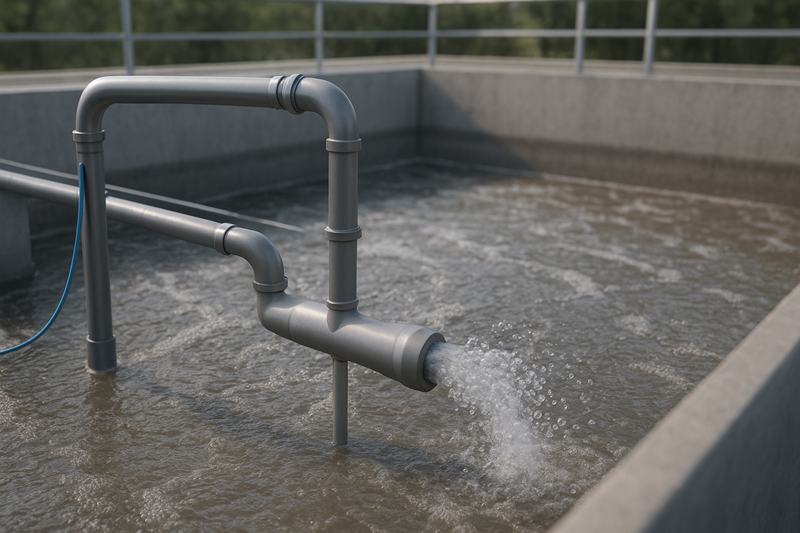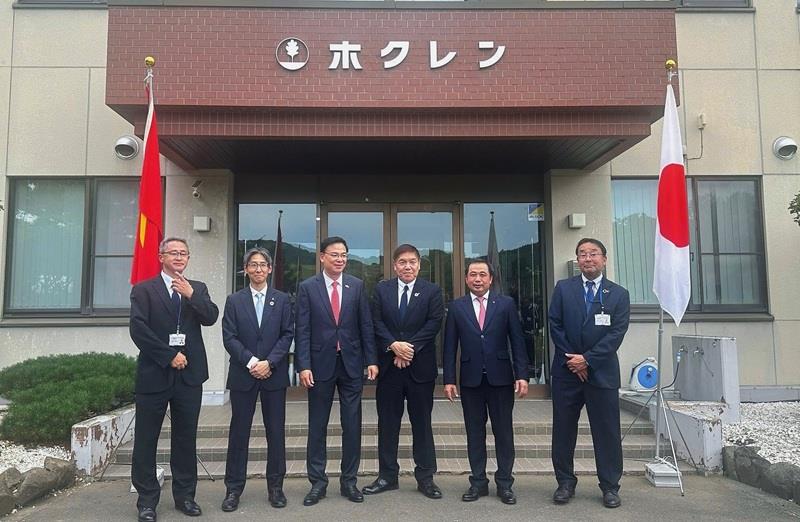
Aeration by venturi tube: A new approach for domestic wastewater treatment
14/10/2025TN&MTIn biological wastewater treatment, oxygen is the “lifeline” sustaining aerobic microorganisms that decompose pollutants. However, oxygen supply typically requires significant energy, accounting for a major portion of operational costs in treatment plants. Addressing this challenge, Phan Xuan Loi, Nguyen Truong Thanh, and Kim Lavane from the College of Environment and Natural Resources, Can Tho University, have developed a novel system that uses a venturi tube combined with a helical mixer to generate microbubbles, thereby enhancing oxygen dissolution in water.
Experimental results indicate that this venturi-based aeration system can effectively replace conventional diffused aeration, achieving comparable treatment efficiency while significantly reducing energy consumption.

Based on hydraulic principles, a venturi tube creates a pressure drop at its throat, allowing air to be drawn in and mixed with water. The air–water interaction generates microbubbles, tiny bubbles with a large surface area and low rising velocity
The role of Oxygen in aerobic activated sludge systems
In domestic wastewater treatment plants, the aerobic activated sludge process is considered the backbone of purification technology. Billions of microorganisms in the aeration tank degrade organic matter and nutrients such as nitrogen and phosphorus, producing clear and safe effluent.
However, microbial activity strongly depends on dissolved oxygen (DO) concentration. When oxygen levels are insufficient, microbial metabolism declines, reducing treatment performance. Conventional aeration systems typically rely on air blowers and porous diffusers, which are energy-intensive, sometimes consuming up to 50% of total plant energy. Therefore, improving oxygen transfer efficiency while minimizing energy use remains a critical research objective.
Concept: Generating microbubbles using a venturi tube
Based on hydraulic principles, a venturi tube creates a pressure drop at its throat, allowing air to be drawn in and mixed with water. The air–water interaction generates microbubbles, tiny bubbles with a large surface area and low rising velocity.
Compared with larger bubbles from conventional diffusers, microbubbles enhance oxygen transfer efficiency (OTE) due to prolonged residence time and improved contact area, enabling a more uniform oxygen distribution throughout the tank and supporting microbial activity even in deeper water layers.
Experiment: Two aeration systems for comparison
To evaluate this approach, the researchers constructed two Sequencing Batch Reactor (SBR) systems using HDPE tanks of 60 L working volume, operated in batch mode with a hydraulic retention time (HRT) of 5.5 hours.
System 1: Aeration by venturi tube combined with a helical mixer
System 2 (Control): Aeration by conventional porous diffuser
Both systems treated identical domestic wastewater under the same operating conditions. Each treatment cycle consisted of 4 hours of aeration, 1 hour of settling, and 30 minutes of decanting.
Results: Comparable pollutant removal with stable Oxygen supply
During operation, the venturi-based aeration system achieved a rapid and stable increase in dissolved oxygen, maintaining an average DO concentration of approximately 7 mg/L, which is sufficient for microbial respiration.
Treatment performance between the two systems was comparable, with removal efficiencies of ~80% for COD and BOD₅, and ~90% for NH₄⁺-N. The Venturi aeration system exhibited slightly lower TSS removal, yet effluent quality still met Column A of the National Technical Regulation on Domestic Wastewater (QCVN 14:2008/BTNMT).
Average effluent concentrations for the two systems were:
- TSS: 26.7 ± 4.2 mg/L (Venturi) and 18.3 ± 5.8 mg/L (Control)
- COD: 36.7 ± 15.5 mg/L and 34.3 ± 11.5 mg/L
- BOD₅: 24.0 ± 6.5 mg/L and 21.1 ± 5.1 mg/L
- NH₄⁺-N: 1.4 ± 0.11 mg/L and 1.26 ± 0.05 mg/L
- NO₃⁻-N: 6.26 ± 0.74 mg/L and 6.07 ± 1.44 mg/L
- PO₄³⁻: 2.9 ± 0.3 mg/L and 3.0 ± 0.37 mg/L
Discussion
The findings demonstrate that venturi-induced microbubble aeration effectively maintains aerobic conditions by enhancing oxygen mass transfer and distribution throughout the activated sludge reactor. This improvement promotes oxidation and nitrification, key steps in nutrient removal.
Importantly, the system operates without high-power air compressors, reducing energy consumption while maintaining equivalent pollutant removal performance. These results support the potential application of hydraulic microbubble aeration in domestic wastewater treatment systems.
Practical implications and future work
Compact, low-cost, and easy to fabricate, the venturi tube offers a promising energy-efficient alternative to conventional aeration. Its integration into activated sludge systems can reduce operational costs and enhance oxygen dissolution efficiency, the critical factor for aerobic biological treatment.
Given these advantages, the system is particularly suitable for small- and medium-scale wastewater treatment plants serving residential areas, schools, hospitals, and industrial facilities with limited investment budgets.
Future studies will focus on pilot-scale applications to further evaluate energy performance, long-term stability, and industrial scalability of the Venturi aeration system.
Viet Anh
Reference: Phan Xuan Loi, Nguyen Truong Thanh, Kim Lavane (2025). “Using venturi tube for air supply in sequencing batch bioreactor to treat domestic wastewater.” College of Environment and Natural Resources, Can Tho University.
















